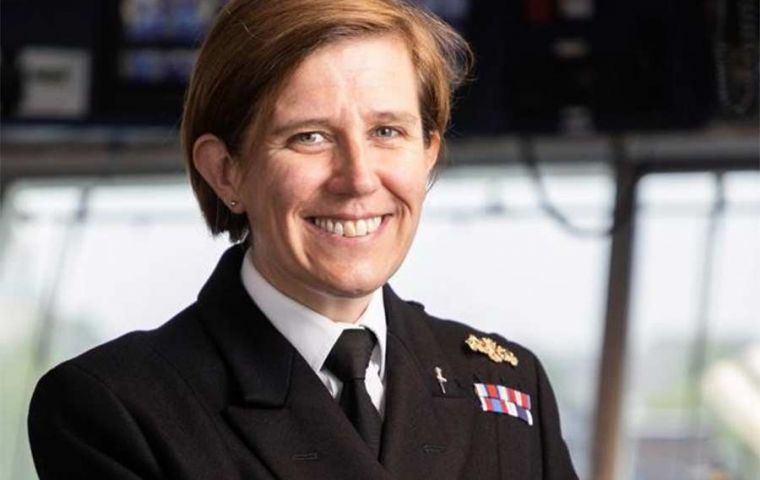MercoPress. South Atlantic News Agency
HMS Protector calls it a season, heads back north
 “After a season of the sun never setting, it will be good to see the stars again,” Captain Ingham said (Pic RN)
“After a season of the sun never setting, it will be good to see the stars again,” Captain Ingham said (Pic RN) The Royal Navy's icebreaker HMS Protector has completed her Antarctic scientific mission for the 2023 Antarctic season safeguarding birdlife and laying the groundwork for further research, it was announced.
Sailors cleared up rubbish then monitored birds on one of the most important islands in the region for our feathered friends, and left behind special markers at key locations around the peninsula, markers which will help them and others accurately – and safely – survey Antarctic waters, the Navy explained on its website.
The Plymouth-based survey ship is on a five-year mission, splitting her time between the hemispheres – from boreal summers venturing into the Arctic to austral summers working in her more traditional realm of the Antarctic Peninsula.
The ship spends four to six weeks at a time – known as a work period – conducting survey work to update charts, working with British and international scientists delivering supplies, supporting research, moving people and equipment around, as well as collecting scientific data.
After delivering supplies to the UK Antarctic Heritage Trust at Port Lockroy – helped earlier in the deployment when the sailors dug out the base following a heavy snowfall – Protector’s hydrographers established a ‘geodetic point’ on Goudier Island, a marker which will serve as an accurate location reference point for future survey work.
“I have had the opportunity to experience different types of surveys including establishing a geodetic mark to collate positional data as well as operating on the survey motor boat, surveying the seabed for depth and safe transit for the ship,” said Able Seaman Abi Potter, a specialist hydrographer. “It has been a great experience and I have thoroughly enjoyed my time in the Antarctic.”
One key mission of the final work period was to deliver supplies and aviation fuel to the British Antarctic Survey base at Rothera, not only a hub for the scientists’ work in the region but also a key link with the South Pole, 1,565 miles away. Just 25 miles from Rothera is the aptly-named Avian Island. Not even one mile long and rising 130ft out of the Antarctic Sea, it is a breeding ground for seven species – more than at most other sites in the region: adélie penguins (77515 breeding pairs estimated in 2013, one of the largest breeding colonies on the Antarctic Peninsula), imperial shags, south polar skuas, brown skuas, southern giant petrels, kelp gulls and Wilson’s storm petrels. Other wildlife seen included Weddell seals, Elephant Seals, and a Chinstrap penguin.
The unique island is protected by international law, but that doesn’t protect it from either the elements or the impact of humanity. An eight-strong team from Protector went ashore to remove rubbish (broken glass, foam, small plastic islands) – thankfully relatively small quantities – and observed the birdlife, in particular southern giant petrels. There was not a large amount of rubbish collected with no litter seen on the beach.
The final survey work was conducted in Bigourdan Fjord using the ship’s survey motorboat, James Caird IV. It swept a safe channel through a narrow passage ahead of Protector herself, leading her through a previously-inaccessible area between Pourquoi Pas Island and Blaiklock Island.
“The opportunity to conduct our operations in areas never before surveyed is very rewarding and a privilege, particularly in regions as special as Antarctica,” said coxswain Chief Petty Officer Stef Merlo. “The products we produce will directly influence tourism and access to the areas to enhance scientific research. Hopefully, this is our small contribution to the future sustainability of our planet.”
With autumn in the Southern Hemisphere approaching, temperatures and ice conditions rule out safe operations around Antarctica so Protector will now begin shifting her focus to work further north for much of the remainder of 2023.
“I am really proud of the work that the team have done this season, whether digging Port Lockroy out of the snow, keeping us fed and supplied with stores, maintaining equipment to keep us at sea or surveying the seabed and collecting vital scientific data,” said Captain Milly Ingham, the first female officer to command a Royal Navy vessel.
“Everyone onboard has had a part to play in our work, which alongside our partner organizations, continues to advance our understanding of this unique environment and thus helps to safeguard it for future generations.
“After a season of the sun never setting, it will be good to see the stars again.” (Source: Royal Navy)




Top Comments
Disclaimer & comment rulesCommenting for this story is now closed.
If you have a Facebook account, become a fan and comment on our Facebook Page!